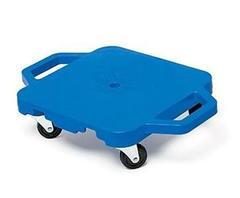Your Cart is Empty

If a child is a sensory seeker, whether they have autism or not, one of the keys to their success is making sure they are provided with sensory supports throughout the school environment that promote regulation, focus, and engagement.
You’ve worked hard to put sensory supports in place at home and it’s important to carry those regulation efforts across the school day too!
We’ve talked about creating a sensory-informed classroom, developing sensory toolboxes, and choosing the just-right fidget or stim toy for your child. Now, the challenge is to put it all together in a sensory diet that works for your child, your family, and the school.
Sensory breaks are the “meals” in your sensory diet and are best planned every 90 minutes to 2 hours. These breaks offer your child large doses of sensory input. This is when your child can jump, crash, squish, brush, spin, swing, and scooter his way to regulation.
Your occupational therapist should create a sequence of therapeutic activities that are tailored to your child’s needs, but you can see below for some of our favorites. This will streamline the sensory break times to be effective and time-conscious.
 Sensory breaks can happen in a corner of a classroom, hallway, resource room, or (if you’re lucky!) a sensory break room. No matter where the location, sensory breaks should offer the necessary intensity and duration of sensory activities that your child needs on a planned, consistent basis.
Sensory breaks can happen in a corner of a classroom, hallway, resource room, or (if you’re lucky!) a sensory break room. No matter where the location, sensory breaks should offer the necessary intensity and duration of sensory activities that your child needs on a planned, consistent basis.
In a school setting, these sensory breaks are best scheduled in consideration of the student’s scheduled activities (academics, specials, recess).
For some kids, recess may be enough of a gross motor opportunity to help them get their wiggles out. For other students, a transitional sensory break may be needed to help them return to a quiet learning environment after all of the excitement. Some students need a morning sensory break to ease the initial transition to school and “wake up” their bodies for learning!
Consider sitting down with your child’s teacher and Occupational Therapist to develop a schedule that meets your child’s regulation needs but does not detract unnecessarily from academic times.
Look at transitional times when sensory breaks could be done en route to the next activity. It may be that what works best is a hybrid of in-class, hallway, and break-room activities! Once the schedule is in place, be sure to revisit whether the sensory breaks are effective and occurring frequently enough (or too often!) to meet your child’s needs.
Sensory snacks are the classroom accommodations, modifications, and sensory tools that ideally already exist in your child’s sensory-informed classroom! These may include fidgets, active seating options, oral sensory options, and built-in classroom movement activities.
You can reference our guide to creating a sensory-informed classroom as a conversation-starter with your new teacher. He or she may already have some great sensory snacks in place for all students that will benefit your child.
Here are some of our favorite sensory snacks and activities to include in the classroom to give you some initial ideas. We have another guide to our 10 favorite sensory activities here.
While this may require a bit more space than you currently have in the classroom, if you can work it into a sensory seeker's recess or gym class, a scooter board is a great option. It gives him or her multiple sources of sensory input.
 This has become a favorite among teachers to use during class since it's low profile and doesn't make any noise. But, what we have seen is that teachers are using these to create "sensory corners" in their classrooms for specific sensory breaks.
This has become a favorite among teachers to use during class since it's low profile and doesn't make any noise. But, what we have seen is that teachers are using these to create "sensory corners" in their classrooms for specific sensory breaks.
You can check out our weighted lap pad to see if it's the right fit for your child's classroom.
While you don't need a giant trampoline to give a child the sensory input they need, finding a small one that fits in the corner of the classroom can be a quick way for a child to get the necessary sensory inputs they need.
While there is a long list of fidget toys, and they have become more of a plaything then therapeutic, we shouldn't discount that they are a quick, easy way for sensory seekers to get a bit of sensory input.
This is very different from the fidget spinners that teachers are having to take away from students who don't actually need the sensory inputs.
 A sensory swing is a great way to give a child a place they can go on their own and help self-regulate if needed.
A sensory swing is a great way to give a child a place they can go on their own and help self-regulate if needed.
This may require some help to get hung up in the classroom, but once it's there, it will become a key part of any child's sensory breaks.
You can see our sensory pod swing here. If your child needs extra sensory input, check out our compression swing!
When it comes to creating sensory breaks for the classroom, it's important to keep the overall sensory diet of students in mind. To help you learn more about sensory diets, here is a Facebook Live session I did covering sensory diets.
Take note of what works and what isn’t as successful in helping your child regulate, as this will save you time at the beginning of each school year in maintaining a sensory diet that works at school and will help you carry over at home.
Do you have any tips or activities to add to the list? Let us know in the comments!
Very educative write up. I really appreciate it. Thank you
Comments will be approved before showing up.


Felicity WALLACE
October 31, 2022
Love all your sensory articles and webinars to help me better support my 8 year old ASD/sensory child and my students I teach in foundation